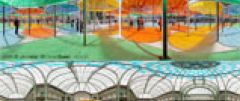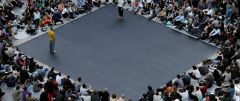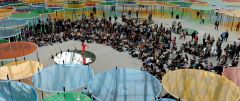Work in situ
The notion of work in situ, as Daniel Buren uses it to describe his art since 1965, means that the work is site-specific; it cannot be envisaged without the setting that it was designed for and built in.
This postulate and method emerged at a time when Buren was experimenting with painting. He quickly realised that “the painting’s surroundings […] always seem richer and more important than the painting itself.” But the decisive nature of the context is often overlooked, ignored or just silently accepted because of “the work’s so-called independence” (it supposedly has an intrinsic content which behaves in the same way under all circumstances). Daniel Buren objects to this idea. He believes that the surroundings have a powerful, unspoken influence on the work: museums in particular impose their constraints and their underlying implications, which are almost always in profound contradiction with the works on display.
Through the idea of work in situ, he tries to reverse this relationship so that the art work transforms the place or at least reveals exactly what it is and what influence it has. The principle is simple: the work’s design, construction and exhibition must be deduced from the site and done on the spot. This method means doing without a studio and refusing the usual formats (canvases that can be transported from one exhibition to another, photos, films, three-dimensional objects, and so on.)
Daniel Buren therefore goes from place to place without knowing in advance what he will do there. His official biography just says he “lives and works in situ”: what counts is making, seeing and experimenting in the place itself. Each installation is unique and is demolished when the exhibition closes (except for long-term commissions), because it cannot be installed anywhere else (the “situated works” are the sole exception). Every work by Daniel Buren is inseparable from its site, acting sometimes in osmosis and sometimes in opposition.
Working in situ, is a way of questioning the artist’s supposed freedom and, more importantly, revealing the unsuspected but significant features of the site, giving a new vision of both the place and the work, which is broadened and perhaps liberated by the process.





